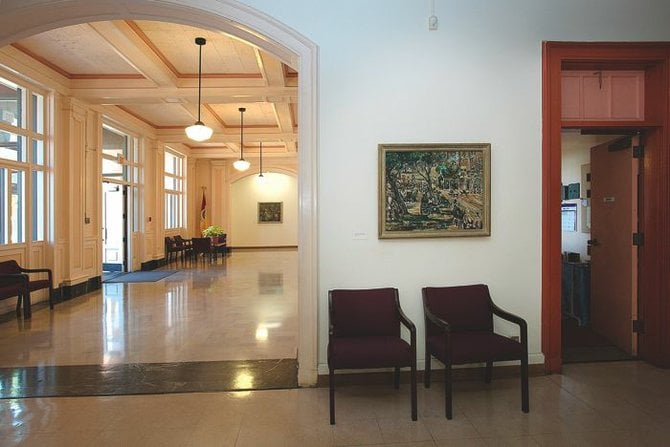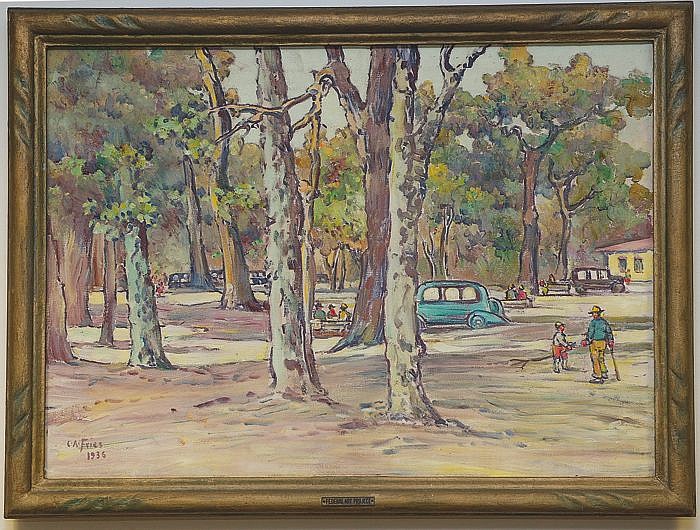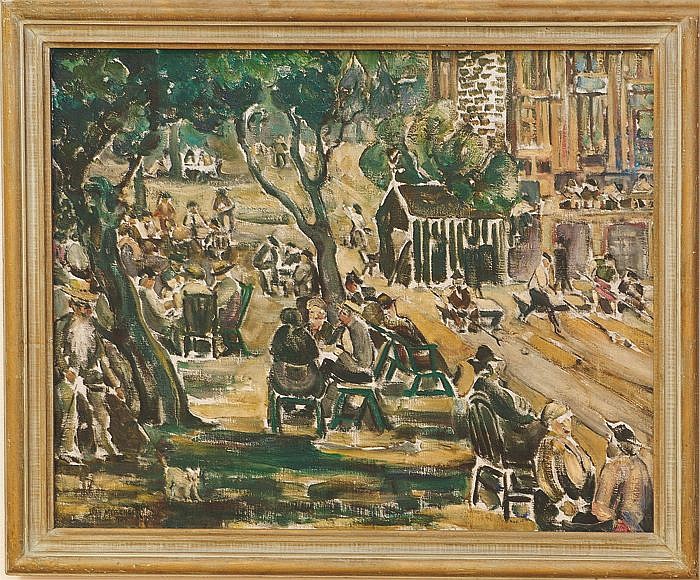 Facebook
Facebook
 X
X
 Instagram
Instagram
 TikTok
TikTok
 Youtube
Youtube

Even if it’s at the expense of the public, the City of San Diego wants to ensure that certain employees of America’s finest city have an appreciation for fine arts — or so it seems, gauging by the quiet transfer of two paintings from downtown’s Central Library to City administrative offices.
According to Marion Hubbard, the library’s senior public information officer, 537,794 visits were made to the venerable Central Library during the 2010 fiscal year; of those half-million or so, an uncounted number can be attributed to the homeless. Whatever their status, library patrons may have, in prior decades, chanced upon two oils of local significance and, in the case of one painting, not inconsiderable value. However, without even pro forma public notice, in 2008 the City whisked the works away to decidedly less-accessible venues, but not until after shelling out taxpayer funds — in the form of a federal grant, a Union-Tribune article reported that year — to have the oily landscapes examined and restored.
In January, I made a request under the California Public Records Act, asking for all documents (including memoranda, emails, reports, and appraisals) pertaining to the transfer of paintings from the Central Library to other locations. What I received in response — a cryptic, one-page blurb for each painting — generates more questions than answers.

According to the official City description, The Picnic Grove, at a framed size of 29.5 inches high and 39.5 inches wide, “depicts a grove of tall trees with several small groups of people seated at picnic tables,” as well as “several roadsters,” a “small yellow building,” and “a man holding a bat.” It’s prosaic stuff, perhaps, but no more so than other California landscapes coveted in recent decades by collectors of regional art.
From what can be gleaned, the City acquired The Picnic Grove in 1936, not long after its completion by Charles A. Fries, a painter whose canvases can be found in tony galleries around the state. One such gallery is Redfern in Laguna Beach, where Fries’s works are featured. I asked Redfern’s owner, Ray Redfern, what The Picnic Grove might fetch on the open market. “It’s from his later period — he died in 1940 — and usually his paintings sell for $5000 to $10,000, sometimes a little more. It depends on the condition, of course.” As for condition, the City (having assigned The Picnic Grove a “conservation priority” of “5” and a “curatorial priority” of “1”) has termed it “excellent.” (Among the questions the City has refused to answer is, What do those numbers mean?) The City has also disclosed that the painting was examined and conserved by Alexis Miller of the Balboa Art Conservation Center on March 25, 2008.
The conservation center, according to its website, is a nonprofit entity “devoted to the preservation of material culture in the areas of art and history.” Like other art conservators, the folks at Balboa Art are highly specialized technicians and far from cheap. Although Miller, associate conservator of paintings, steadfastly refused to answer my questions, a perusal of art conservation websites and fine art galleries reveals typical charges of $90-plus an hour, with a commonplace bill of $1000 to $3000 to examine and restore a modest-size oil that doesn’t require extensive work.

The Neal Deal/Senior Citizens in Balboa Park, like The Picnic Grove, is a Depression-era oil that ended up in the hands of the City of San Diego via murky pathways; the City describes its legal status as “orphan.” Painted by Ivan Messenger in 1934, it’s a rectangle 30.5 inches high and 36.5 inches long, described as depicting “several groups of senior citizens seated at wooden tables beneath tall trees beside the shuffleboard court off Sixth Avenue.” Ray Redfern estimates that it might sell for $1000 or so. (Among the cognoscenti of the regional art scene, Messenger is considered a rung below Fries, who, according to Redfern, is a “second-tier” painter but still deemed highly collectible.) As was the case with The Picnic Grove, Senior Citizens was also tended to by the Balboa Art Conservation Center; when inspected by conservator Betsy Court on April 12, 2006, its condition was listed as “fair,” and it was tagged with conservation and curatorial priorities of “5”and “2,” respectively. Court completed conservation on May 20, 2008, and adjudged the painting’s condition “excellent” on August 28, 2008.
To be fair, the peripatetic canvases in question would register faintly, if at all, in the aesthetic psyches of most San Diegans: neither Fries nor Messenger is a household name. Nonetheless, the question arises: were these depictions of local life intended for the eyes of the public — versus public employees?
From what can be gleaned, the City’s role as caretaker of fine art arose in 1936, apparently not long after Charles Fries completed The Picnic Grove. According to a document provided by the Library Department, the painting was acquired that year under the auspices of a “long-term loan” from the federal government. (In bureau-speak, the loan was “Courtesy of the Fine Arts Program, Public Buildings Service, U.S. General Services Administration, Commissioned through the New Deal Art Projects.”) Senior Citizens may have been acquired several decades later; the City has given it a “legal date” of January 1, 1963, presumably the date it ended up as a City asset.
Hubbard claims that the decision to move the paintings was motivated by the desire “to offer some rotation in exhibition of the City’s art.” Plausible enough, but who’s checking out the landscapes nowadays? According to the City, The Picnic Grove now resides in Suite 300 of the Civic Center Plaza, the lobby of the Personnel Department; Hubbard says that around 45 people work there but the number of visitors is “unknown.” As for Senior Citizens, the shuffleboarders can now be viewed by the 34 employees at Park and Rec’s administration building in Balboa Park, located in what’s left of the old Navy Hospital, as well as another indeterminate group of visitors.
Hubbard — mouthpiece for library director Deborah Barrow — says the decision to move the paintings was made by the staff of the San Diego Commission for Arts and Culture “in consultation” with their counterparts at other City departments — Library, Personnel, and Park and Recreation. But when queried, neither Barrow nor Hubbard will identify the staff members ultimately responsible for the transfer. Moreover, the City refuses to reveal anything about the paperwork behind the paintings, niceties such as titles, loan documents, or inventory logs that might tell the history of the paintings. Could it be that the prior owners — as a condition of a loan or donation — might have stipulated that these works remain in the Central Library for enjoyment by the general public? Were they intended to grace the hallways of select groups of City functionaries? The City won’t say.
In the world of museums and galleries, the history of a work — how it traveled from artist to owner to owner — is referred to as “provenance” and is seen as vital in determining the authenticity and value of an objet d’art. Art historians and collectors alike dwell on the concept. But the City of San Diego refuses to fill in the missing pieces of the provenance puzzle. In late March, I sent my second public records request, which included a narrowly tailored inquiry regarding the two paintings, as well as specific follow-up questions directed at Hubbard. I received from library director Barrow this statement:
“The City performed a reasonable search…and the documents sent to you [two pages]…constitute all of the documents located from that search and we consider this matter closed.”
She also claims that my follow-up request “is not focused [or] specific” and “would create an undue burden on the City.”
Finally, she protests that complying with the records request would “not be an efficient use of taxpayers’ monies.”


Even if it’s at the expense of the public, the City of San Diego wants to ensure that certain employees of America’s finest city have an appreciation for fine arts — or so it seems, gauging by the quiet transfer of two paintings from downtown’s Central Library to City administrative offices.
According to Marion Hubbard, the library’s senior public information officer, 537,794 visits were made to the venerable Central Library during the 2010 fiscal year; of those half-million or so, an uncounted number can be attributed to the homeless. Whatever their status, library patrons may have, in prior decades, chanced upon two oils of local significance and, in the case of one painting, not inconsiderable value. However, without even pro forma public notice, in 2008 the City whisked the works away to decidedly less-accessible venues, but not until after shelling out taxpayer funds — in the form of a federal grant, a Union-Tribune article reported that year — to have the oily landscapes examined and restored.
In January, I made a request under the California Public Records Act, asking for all documents (including memoranda, emails, reports, and appraisals) pertaining to the transfer of paintings from the Central Library to other locations. What I received in response — a cryptic, one-page blurb for each painting — generates more questions than answers.

According to the official City description, The Picnic Grove, at a framed size of 29.5 inches high and 39.5 inches wide, “depicts a grove of tall trees with several small groups of people seated at picnic tables,” as well as “several roadsters,” a “small yellow building,” and “a man holding a bat.” It’s prosaic stuff, perhaps, but no more so than other California landscapes coveted in recent decades by collectors of regional art.
From what can be gleaned, the City acquired The Picnic Grove in 1936, not long after its completion by Charles A. Fries, a painter whose canvases can be found in tony galleries around the state. One such gallery is Redfern in Laguna Beach, where Fries’s works are featured. I asked Redfern’s owner, Ray Redfern, what The Picnic Grove might fetch on the open market. “It’s from his later period — he died in 1940 — and usually his paintings sell for $5000 to $10,000, sometimes a little more. It depends on the condition, of course.” As for condition, the City (having assigned The Picnic Grove a “conservation priority” of “5” and a “curatorial priority” of “1”) has termed it “excellent.” (Among the questions the City has refused to answer is, What do those numbers mean?) The City has also disclosed that the painting was examined and conserved by Alexis Miller of the Balboa Art Conservation Center on March 25, 2008.
The conservation center, according to its website, is a nonprofit entity “devoted to the preservation of material culture in the areas of art and history.” Like other art conservators, the folks at Balboa Art are highly specialized technicians and far from cheap. Although Miller, associate conservator of paintings, steadfastly refused to answer my questions, a perusal of art conservation websites and fine art galleries reveals typical charges of $90-plus an hour, with a commonplace bill of $1000 to $3000 to examine and restore a modest-size oil that doesn’t require extensive work.

The Neal Deal/Senior Citizens in Balboa Park, like The Picnic Grove, is a Depression-era oil that ended up in the hands of the City of San Diego via murky pathways; the City describes its legal status as “orphan.” Painted by Ivan Messenger in 1934, it’s a rectangle 30.5 inches high and 36.5 inches long, described as depicting “several groups of senior citizens seated at wooden tables beneath tall trees beside the shuffleboard court off Sixth Avenue.” Ray Redfern estimates that it might sell for $1000 or so. (Among the cognoscenti of the regional art scene, Messenger is considered a rung below Fries, who, according to Redfern, is a “second-tier” painter but still deemed highly collectible.) As was the case with The Picnic Grove, Senior Citizens was also tended to by the Balboa Art Conservation Center; when inspected by conservator Betsy Court on April 12, 2006, its condition was listed as “fair,” and it was tagged with conservation and curatorial priorities of “5”and “2,” respectively. Court completed conservation on May 20, 2008, and adjudged the painting’s condition “excellent” on August 28, 2008.
To be fair, the peripatetic canvases in question would register faintly, if at all, in the aesthetic psyches of most San Diegans: neither Fries nor Messenger is a household name. Nonetheless, the question arises: were these depictions of local life intended for the eyes of the public — versus public employees?
From what can be gleaned, the City’s role as caretaker of fine art arose in 1936, apparently not long after Charles Fries completed The Picnic Grove. According to a document provided by the Library Department, the painting was acquired that year under the auspices of a “long-term loan” from the federal government. (In bureau-speak, the loan was “Courtesy of the Fine Arts Program, Public Buildings Service, U.S. General Services Administration, Commissioned through the New Deal Art Projects.”) Senior Citizens may have been acquired several decades later; the City has given it a “legal date” of January 1, 1963, presumably the date it ended up as a City asset.
Hubbard claims that the decision to move the paintings was motivated by the desire “to offer some rotation in exhibition of the City’s art.” Plausible enough, but who’s checking out the landscapes nowadays? According to the City, The Picnic Grove now resides in Suite 300 of the Civic Center Plaza, the lobby of the Personnel Department; Hubbard says that around 45 people work there but the number of visitors is “unknown.” As for Senior Citizens, the shuffleboarders can now be viewed by the 34 employees at Park and Rec’s administration building in Balboa Park, located in what’s left of the old Navy Hospital, as well as another indeterminate group of visitors.
Hubbard — mouthpiece for library director Deborah Barrow — says the decision to move the paintings was made by the staff of the San Diego Commission for Arts and Culture “in consultation” with their counterparts at other City departments — Library, Personnel, and Park and Recreation. But when queried, neither Barrow nor Hubbard will identify the staff members ultimately responsible for the transfer. Moreover, the City refuses to reveal anything about the paperwork behind the paintings, niceties such as titles, loan documents, or inventory logs that might tell the history of the paintings. Could it be that the prior owners — as a condition of a loan or donation — might have stipulated that these works remain in the Central Library for enjoyment by the general public? Were they intended to grace the hallways of select groups of City functionaries? The City won’t say.
In the world of museums and galleries, the history of a work — how it traveled from artist to owner to owner — is referred to as “provenance” and is seen as vital in determining the authenticity and value of an objet d’art. Art historians and collectors alike dwell on the concept. But the City of San Diego refuses to fill in the missing pieces of the provenance puzzle. In late March, I sent my second public records request, which included a narrowly tailored inquiry regarding the two paintings, as well as specific follow-up questions directed at Hubbard. I received from library director Barrow this statement:
“The City performed a reasonable search…and the documents sent to you [two pages]…constitute all of the documents located from that search and we consider this matter closed.”
She also claims that my follow-up request “is not focused [or] specific” and “would create an undue burden on the City.”
Finally, she protests that complying with the records request would “not be an efficient use of taxpayers’ monies.”
Comments